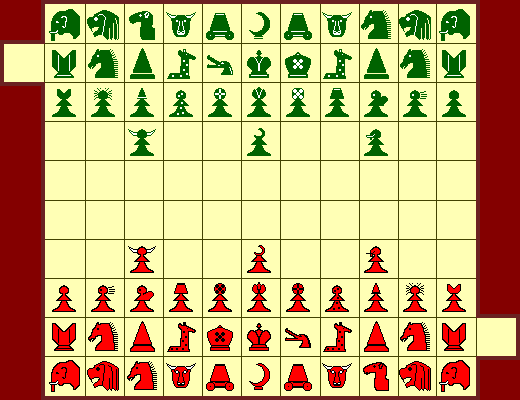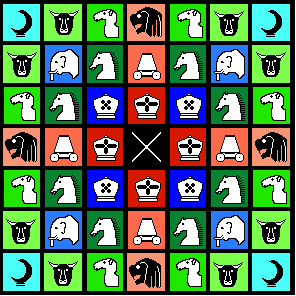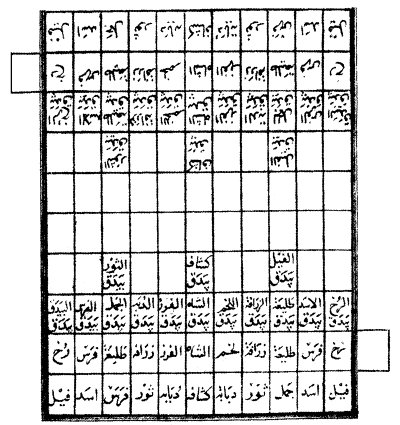Full Tamerlane Chess
Different representations exist for Tamerlane Chess. Maybe the most intriguing is when some additional pieces come to fill vacant spaces.
This happens in a Persian manuscript called "Elliott 274", authored by al-Amuli (14th c.) which contains a Scout (Kashshaf) in f1 and a Lion (Shur) in j1. According to Murray (History of Chess), the rest can not be read.
The same piece are also found in an Arab manuscript, named ms 7322, from the British Museum which reproduces ‘Arabshah's work (15th c.).
Copy of ms 7322, cleaned from Pritchard (ECV)
DESCRIPTION:
The board is the regular Tamerlane Chess board with 112 squares : 10 lines x 11 columns with two "citadel" squares.
Forbes who described this variant made many mistakes in his report, most probably purposely in trying to describe a more "logical" array. Murray followed him, apparently without further checking and he then made the same errors. Several internauts, reading Arabic, have reacted and gave the correct name of all pieces. Ivan A Derzhanski has strong linguistic knowledge and he made a decisive contribution in translating the ms 7322 diagram. We are very much grateful to him for his work.
Indeed, the result is sometimes striking and hurting our logic. However, it is what it is and we should not corrupt it.
Every player has 36 pieces. They are: 1 Shah, 1 Minister (Ferz), 1 "Sea Monster" (Luxm), 2 Giraffes (Zurafa) , 2 Vanguards (Tali'a), 3 Horses, 1 Camel, 2 "Rukhs", 2 "Dabbabas", , 2 Elephants, 2 Lions (‘Asad), 2 Bulls (Thaurs), 1 Revealer (Kashshaf) and 14 Pawns. Pawns are all different: they were miniature reproduction of one given major piece.
On the 3rd line, from left to right, they are:
![]() Pawn
of Pawn,
Pawn
of Pawn,
![]() Pawn
of Horses,
Pawn
of Horses,
![]() Pawn
of Camels,
Pawn
of Camels,
![]() Pawn
of Dabbâbas,
Pawn
of Dabbâbas,
![]() Pawn
of Minister,
Pawn
of Minister,
![]() Pawn
of Shah,
Pawn
of Shah,
![]() Pawn
of Sea Monster,
Pawn
of Sea Monster,
![]() Pawn
of Giraffes,
Pawn
of Giraffes,
![]() Pawn
of Vanguards,
Pawn
of Vanguards,
![]() Pawn of Lion,
Pawn of Lion,
![]() Pawn
of Rukhs. On the 4th rank, from left to right, they are:
Pawn
of Rukhs. On the 4th rank, from left to right, they are:
![]() Pawn of Bull,
Pawn of Bull,
![]() Pawn of Revealer,
Pawn of Revealer,
![]() Pawn
of Elephants.
Pawn
of Elephants.

Correct setup translating the manuscript illustration
The starting array shows some peculiarities:
On 1st line, there is only 1 Camel. The missing Camel is replaced by a third Horse!
On 1st line, the middle piece is a Scout. Forbes and Murray presented it as a Sentinel, but according the Arabic speaking readers, this was not correct. The correct meaning of Kashshâf is Revealer, Scout, Tracker.
On the 2nd line, the Vizir of Tamerlane Chess is replaced by a Luxm (or Lakham). This world is translated by shark, barracuda in modern dictionaries. Forbes and Murray saw a "Crocodile" there. Well, we got the idea, a kind of aquatic monster... Maybe, this translate the way the scribe was seeing his Vizir!
On the 3rd line, Forbes and Murray were completely wrong in their listing of Pawns. In particular, Pawn of Lions is on that line, not on 4th line.
On the 4th line, the Pawns from both side are arranged in a mirror symetry (Pawn of Bulls facing its counterpart), which not the case for the pieces and Pawns on 2nd and 3rd lines!
Are those peculiarities mistakes from the copyist? One can think that they are. But, it is intriguing to see that both sides present exactly the same "mistakes". So, it can be seriously doubted that they are mistakes. Therefore, it is more advisable to present the array exactly as the original manuscript did it.
RULES:
Alas, no rules have been reported for this particular variant of Tamerlane Chess.
Then, there is a place for conjoncture and several writers - including me - have tried to propose moves for the new pieces.
Moves proposed by Forbes
Forbes in 1860 was, in our knowledge, the first to make a proposal. He proposed a Lion combining the moves of Rukh and Giraffe, a Bull combining Vanguard and Giraffe (note that Forbes called the Vanguard a Scout, and gave it the move of our modern Bishop), a Revealer (that he called a Sentinel) combining Vanguard and Rukh, then being identical to a modern Queen. His Crocodile was assumed identical to the regular Vizir.
My personal proposed moves
My proposed reconstruction is based on the analysis that was made by Persian authors for regular Tamerlane Chess. They classified the pieces in 3 classes and 3 powers.
|
Power / Class |
Straight |
Oblique |
Mixed |
|
Primary |
Vizir |
Minister |
Horse |
|
Median |
Dabbâba |
Elephant |
Camel |
|
Extreme |
Rukh |
Vanguard |
Giraffe |
Then, perhaps the 3 new pieces were constituting a 4th power of this table?
|
Long range |
Lion |
Revealer |
Bull |
![]() Lion: jumps to the 3rd square orthogonally (i.e. along
lines or columns).
Lion: jumps to the 3rd square orthogonally (i.e. along
lines or columns).
![]() Revealer: jumps to the 3rd square diagonally.
Revealer: jumps to the 3rd square diagonally.
![]() Bull: jumps making 1orthogonal step followed by 2 diagonal
steps.
Bull: jumps making 1orthogonal step followed by 2 diagonal
steps.
In addition,
![]() Crocodile: moves like the Vizir, 1 adjacent step (4
"orthogonal" directions: front, back, left, right).
Crocodile: moves like the Vizir, 1 adjacent step (4
"orthogonal" directions: front, back, left, right).
The moves of median, extreme and long range pieces can be summarized on these diagrams:

Proposed moves of median, extreme and long range pieces in Full Tamerlane Chess. Piece symbols show the squares reached by that piece from the central square
EXTERNAL LINKS:
http://www.chessvariants.org/historic.dir/tamerlanearab.html







